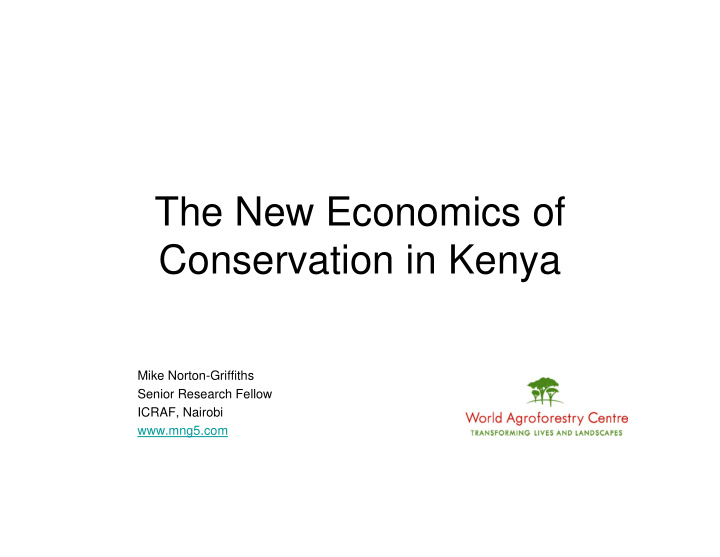



The New Economics of Conservation in Kenya Mike Norton-Griffiths Senior Research Fellow ICRAF, Nairobi www.mng5.com
System Response of Kenya’s Rangelands over the last 35 Years 10 8.6 % Change over 30 years 5 4.4 3.1 0.6 0 -3.2 -5 (A) Wildl (B) Lvstck (C) Pop (D) Offtake (E) Cult System Response
Livestock Dynamics • Overall Trend 70s to 00s of +0.6% per annum (not statistically significant, i.e. marked annual variation but no overall trend ) • Offtake: of cattle, growing at +4.4% per annum • Offtake: of small stock, falling fast • Seen in all 19 ASAL Districts
Livestock Dynamics Suggests a switch from extensive to more intensive methods of production, with greater involvement in the cash economy
Wildlife Dynamics • Overall trend mid ‘70s to mid ‘00s: -3.2% pa • Western’s recent analyses suggests that the trend has continued unchecked, and is now as strong inside the Protected Areas as outside. • Joe Ogutu’s recent paper on wildlife losses in the Mara
Interactions Interactions between cultivation, wildlife and livestock – Mara Area 50 40 30 Density 20 10 0 0 5 10 15 20 Crop Cover Density (Ha/km2) WIldlife TLUs Livestock TLUs
System Response of Kenya’s Rangelands over the last 35 Years 10 8.6 % Change over 30 years 5 4.4 3.1 0.6 0 -3.2 -5 (A) Wildl (B) Lvstck (C) Pop (D) Offtake (E) Cult System Response
Why are the returns to wildlife so low? –Policy Failures –Institutional Failures –Market Failures
Evolution of Property Rights Along with this fundamental change in the pastoral production system we see a rapid transformation of property rights from large parcels of land under Group or Communal ownership to small parcels of land under Private ownership
Property Rights in the Mara Area ≈ 43 large Group Ranches
Property Rights in the Mara Area ≈ 60,000 small private plots
Same process in the Kitengela
IMPACTS: Sub-Division Influences on Wildlife Losses Size of Landholding Size of Holding 25 20 • For every % decrease in size of ) s e r landholding:- a t c 15 e h ( e z i • 0.4% LOSS of diversity S 10 h c n • 2% LOSS of density a R 5 0 50000 40000 30000 20000 10000 0 Diversity & Density of Wildlife Diversity Density
Main Drivers of Sub Division Defensive – To improve security of tenure from corrupt group ranch committees from political and economic elites from conservation NGOs – To prevent the further dilution of group or communally owned resources Opportunistic - To capture revenue streams - To capture rising land values
Opportunistic Drivers of Sub-Division • Opportunistic (1) - Capturing Revenue Streams – To capture revenue streams from agricultural, livestock and wildlife production directly at the household level rather than through local institutions such as group ranch committees. • Opportunistic (2) - Capturing Rising Land Values – Sub-divided land immediately acquires value to the owner and is now worth investing in. – Growth of urban markets creates a burgeoning demand for greater quantity and higher quality of production. – Sub-division requires production to be intensified: owners respond by investing in methods of higher intensity production, land values rise with such investment. – In peri-urban areas, the near exponential growth in the demand for land for domestic and commercial use triggers precipitous rise in land values, and land becomes completely dislinked from its agro-ecological potential.
The New Conservancy Movement
Property Rights
Recommend
More recommend